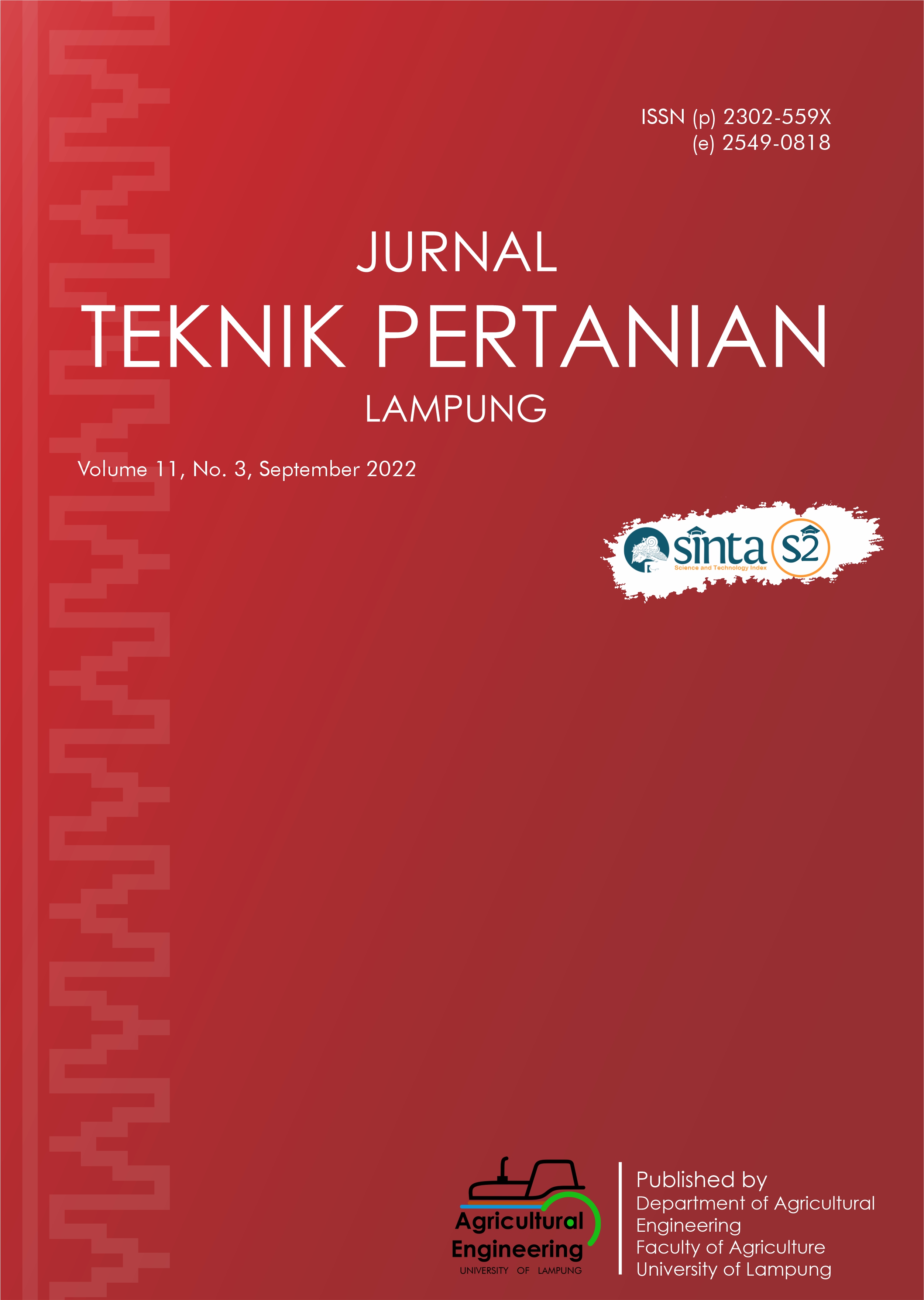Physical Quality of Fresh Cayenne Pepper (Capsicum frutescens L.) with Different Types of Packaging during Low Temperature Storage
DOI:
https://doi.org/10.23960/jtep-l.v11i3.378-395Abstract
Cayenne pepper (Capsicum frutescens L.) is classified as a horticulture product that easly damaged and it can only survive for 2-3 days in room temperature conditions. In maintaining the quality and self life time of fresh cayenne pepper during storage it is recommended to use the packaging and storage at low temperature. The purpose of this study is to analize the effect of packaging type and storage length on the physical quality of fresh cayenne pepper during low temperature storage (5°C). This study used a complete randomized design method with two factors, each of which consisted of 3 levels, namely storage time (4, 8, and 12 days) and type of packaging (vacuum pack, perforated polypropyline plastic, and wrap plastic). The data were analized by using factorial Anova two mix factors test (±= 5%) and was followed up by Tukey test. The results showed that the best packaging was found in perforated polypropylene plastic with the lowest moisture content 76.45%, the lowest weight loss 3.87%, the highest texture (hardness) 0.027 N/mm2, the highest lightness (L*) 44.52, the lowest redness (a*) 26.7, the lowest yellowness (b*) 10.97, the lowest "E 23.47, and the lowest water activity 0.889. Physical quality of fresh cayenne pepper can last up to 12 days at low temperature storage (5°C) using perforated polypropylene plastic.
Keywords: Cayenne pepper, packaging, storage, low temperature, physical quality.
References
Anggraini, R. (2020). Penilaiaan organoleptik cabai rawit dengan kemasan ramah lingkungan berbahan daun. Agrofood Jurnal Pertanian dan Pangan, 2(2), 9-16.
Blongkod, N.A., Wenur, F., & Longdong, I.A. (2016). Kajian pengaruh pra pendinginan dan suhu penyimpanan terhadap umur simpan brokoli. Cocos, 7(5), 1-10.
BPS (Badan Pusat Statistik). (2020). Produksi Tanaman Sayuran. [Diakses pada 19 Mei 2022 dari https://www.bps.go.id/indicator/55/61/1/produksi-tanaman-sayuran.html.]
David, J. (2018). Teknologi untuk memperpanjang masa simpan cabai. Jurnal Pertanian Agros, 20(1), 22-28.
Hadisoemarto, T. (2003). Modifikasi atmosfer dalam pengemasan (MAP) untuk produk hortikultura segar dan pengaruhnya terhadap pertumbuhan patogen. Buletin Penelitian, 25(2), 22-31.
Kumalaningsih, S., Harijono, & Amir, Y.F. (2012). Pencegahan pencoklatan umbi jalar (Ipomea batatas (L.) Lam.) untuk pembuatan tepung: Pengaruh kombinasi konsentrasi asam askorbat dan sodium acid pyrophospate. Jurnal Teknologi Pertanian, 5(1), 11-19.
Lamona, A., Purwanto, Y.A., & Sutrisno, S. (2015). Pengaruh jenis kemasan dan penyimpanan suhu rendah terhadap perubahan kualitas cabai merah keriting segar. Jurnal Keteknikan Pertanian, 3(2), 145–152.
Nurdjannah, R., Purwanto, Y.A., & Sutrisno, S. (2014). Pengaruh jenis kemasan dan penyimpanan dingin terhadap mutu fisik cabai merah. Jurnal Penelitian Pascapanen Pertanian, 11(1), 19–29.
Putri, Y.R., Khuriyati, N., & Sukartiko, A.C. (2020). Analisis pengaruh suhu dan kemasan pada perlakuan penyimpanan terhadap kualitas mutu fisik cabai merah keriting (Capsicum annum L.). Jurnal Teknologi Pertanian, 21(2), 80-93.
Sakti, H., Lestari, S., & Supriadi, A. (2016). perubahan mutu ikan gabus (Channa striata) asap selama penyimpanan. Jurnal Teknologi Hasil Perikanan, 5(1), 11–18.
Santika. (2004). Agribisnis Cabai. Jakarta: Penebar Swadaya.
Sari, S.R., Agustini, S., Wijaya, A., & Pambayun, R. (2017). Profil mutu ikan lele (Clarias gariepinus) asap yang diberi perlakuan gambir (Uncaria gambir Roxb). Jurnal Dinamika Penelitian Industri, 28(2), 101–111.
Sembiring, N.N. (2009). Pengaruh Jenis Bahan Pengemas Terhadap Kualitas Produk Cabai Merah (Capsicum annum L.) Segar Kemasan Selama Penyimpanan Dingin. [Master Thesis]. Medan: Universitas Sumatera Utara.
Siswati, S. (2009). Pengaruh Penambahan Kulit Buah Melinjo dan Lama Penyimpanan Terhadap Kualitas Puree Cabai Merah Keriting (Capsicum annum L.). [Undergraduate Thesis]. Jambi: Universitas Jambi.
Sulistyaningrum, A., & Darudriyo, D. (2018). Penurunan kualitas cabai rawit selama penyimpanan dalam suhu ruang. Jurnal Agronida, 4(2), 64–71.
Susilowati, S. (2008). Isolasi dan Identifikasi Senyawa Karotenoid dari Cabai Merah (Capsicum annum Linn.). [Undergraduate Thesis]. Malang: Fakultas Sains dan Teknologi, Universitas Islam Negeri Maulana Malik Ibrahim.
Waryat, W., & Handayani, Y. (2020). Implementasi jenis kemasan untuk memperpanjang umur simpan sayuran pakcoy. Jurnal Ilmiah Respati, 11(1), 33–45.
Widhiantari, I.A., Sutan, S.M., & Djoyowasito, G. (2016). Rancangan wadah buah tomat untuk menahan getaran selama transportasi berbahan eceng gondok dan pelepah pisang. The Indonesian Green Technology Journal, 5(1), 1-6.
Widianty, E. (2015). Pengaruh Jenis Kemasan dan Jumlah Perforasi Kemasan Terhadap Karakteristik Jamur Champignon (Agaricus bisporus) yang Disimpan pada Suhu Rendah. [Undergraduate Thesis]. Bandung: Program Studi Teknologi Pangan Universitas Pasundan.
Winarno, F.G. (2002). Kimia Pangan dan Gizi. Jakarta: Gramedia Pustaka Utama.
Wulandari, L.A. (2019). Pengaruh Konsentrasi dan Waktu Aplikasi CaCl2 Terhadap Fisikokimia Buah Tomat (Lycopersicum esculentum Mill.). [Master Thesis]. Jember: Fakultas Peranian Universitas Jember.
Wulandari, S., Bey, Y., & Tindaon, K.D. (2012). Pengaruh jenis bahan pengemas dan lama penyimpanan terhadap kadar vitamin C dan susut berat cabai rawit (Capsicum frutescens L.). Jurnal Biogenesis, 8(2), 23-30.
Downloads
Published
Issue
Section
License
- Authors who publish with this journal agree to the following terms:
- Authors retain copyright and grant the journal right of first publication with the work simultaneously licensed under a Creative Commons Attribution-ShareAlike 4.0 International Lice that allows others to share the work with an acknowledgement of the work's authorship and initial publication in this journal.
- Authors are able to enter into separate, additional contractual arrangements for the non-exclusive distribution of the journal's published version of the work (e.g., post it to an institutional repository or publish it in a book), with an acknowledgement of its initial publication in this journal.
- Authors are permitted and encouraged to post their work online (e.g., in institutional repositories or on their website) prior to and during the submission process, as it can lead to productive exchanges, as well as earlier and greater citation of published work (See The Effect of Open Access).
Jurnal Teknik Pertanian Lampung

JTEPL is licensed under a Creative Commons Attribution-ShareAlike 4.0 International License.

